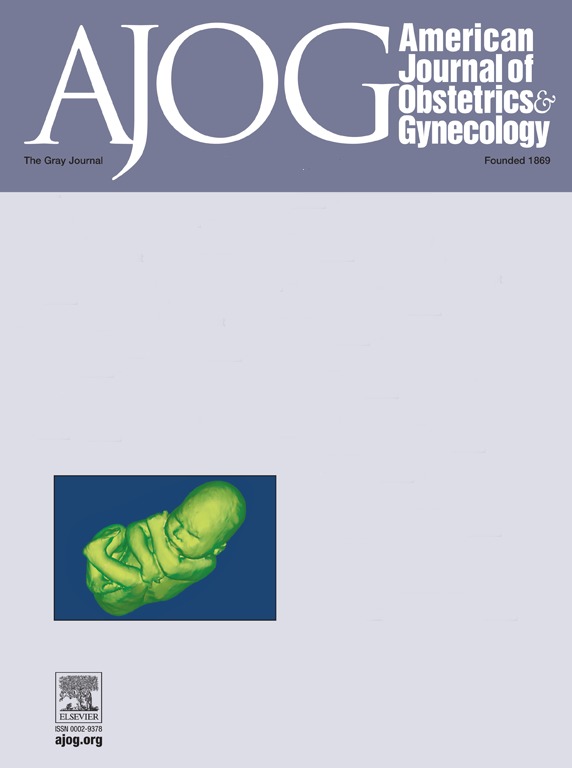一旦患有妊娠糖尿病,就永远患有妊娠糖尿病?妊娠期糖尿病妊娠前非妊娠期糖尿病妊娠的孕产妇和新生儿结局-一项回顾性队列研究。
IF 8.7
1区 医学
Q1 OBSTETRICS & GYNECOLOGY
引用次数: 0
摘要
背景:没有妊娠期糖尿病(GDM)但在妊娠前被诊断为GDM的孕妇的孕产妇和新生儿结局信息有限。目的:调查先前诊断为GDM但未在随后妊娠中出现类似糖尿病相关并发症的个体,尽管缺乏诊断。研究设计:采用回顾性队列设计,包括2012年7月至2022年12月期间在三级医疗中心至少连续两次分娩的个体。参与者被分为三组:两次怀孕都有GDM的个体(第一组),第一次怀孕有GDM但随后的怀孕没有GDM(第二组),两次怀孕都没有GDM(第三组)。比较各组的各种糖尿病相关并发症。结果研究人群包括19,703人。与3组相比,2组的巨大儿(OR 1.4, 95% CI 1.01 ~ 1.92, p=0.03)、大胎龄儿(OR 1.6, 95% CI 1.2 ~ 2.0, p<0.01)和先兆子痫(OR 2.35, 95% CI 1.32 ~ 4.15, p<0.01)发生率较高。LGA巨大儿和先兆子痫的发生率在1组和2组之间相似。与3组相比,1组和2组孕产妇-新生儿综合不良结局显著升高(OR 1.48, 95% CI 1.23-1.77, p<0.01); OR 1.91, 95% CI 1.58-2.3, p<0.01;分别)。在多变量回归中,与3组相比,1组和2组的综合母婴结局的调整OR(考虑第二胎前BMI、第二胎年龄和胎次)分别为1.75 (95% CI 1.36-2.25, p<0.01)和1.30 (95% CI 1.01-1.67, p=0.03)。选择性剖宫产率1组(22%)和2组(13%)高于3组(8.7%)。然而,第1组的发病率也明显高于第2组。早产率1组高于3组(OR为1.7,1.2 ~ 2.3,p<0.01), 2组高于3组。结论:既往妊娠有GDM病史但未在后续妊娠中发生糖尿病相关并发症的风险增加,包括先兆子痫、巨大儿和LGA。研究结果表明,这些人可能有潜在的胰岛素抵抗,以及其他仍在发生的风险因素,他们没有被诊断为GDM并不能消除不良后果的风险。本文章由计算机程序翻译,如有差异,请以英文原文为准。
Once Gestational diabetes, always Gestational diabetes? Maternal and neonatal outcomes of pregnancies with gestational diabetes preceding non gestational diabetes pregnancy- A retrospective cohort study.
BACKGROUND
There is limited information about maternal and neonatal outcomes of pregnant individuals without gestational diabetes mellitus (GDM), who were diagnosed with GDM in the preceding pregnancy.
OBJECTIVE
To investigate whether individuals previously diagnosed with GDM but not in subsequent pregnancy present similar diabetes-related complications, despite the lack of diagnosis Study Design: A retrospective cohort design was employed, including individuals with at least two consecutive births at a tertiary Medical Center between July 2012 and December 2022. Participants were categorized into three groups: individuals with GDM in both pregnancies (group 1), GDM in the first pregnancy but not in the subsequent pregnancy (group 2), and no GDM in both pregnancies (group 3). Groups were compared for various diabetes-related complications.
RESULTS
The study population comprised 19,703 individuals . Group 2 showed higher rates of macrosomia (OR 1.4, 95% CI 1.01-1.92, p=0.03) large-for-gestational-age (LGA) (OR 1.6, 95% CI 1.2-2.0, p<0.01) and preeclampsia (OR 2.35, 95% CI 1.32-4.15, p<0.01) when compared to group 3. Rates of LGA macrosomia and preeclampsia were similar between group 1 and 2. The composite maternal-neonatal adverse outcome was significantly elevated in groups 1 and 2 compared to group 3 (OR 1.48, 95% CI 1.23-1.77, p<0.01 and OR 1.91, 95% CI 1.58-2.3, p<0.01; respectively). In a multivariate regression, the adjusted OR (accounting for BMI before 2nd birth, age at 2nd birth and parity) for composite maternal-neonatal outcomes was 1.75 (95% CI 1.36-2.25, p<0.01) and 1.30 (95% CI 1.01-1.67, p=0.03) in groups 1 and 2 respectively, compared to group 3. Elective cesarean delivery rate was higher in groups 1 (22%) and 2 (13%) compared to group 3 (8.7%). However, the rate was also significantly higher in group 1 versus 2. Preterm birth rates were higher in group 1 (OR 1.7, 1.2-2.3, p<0.01) but not 2, when compared to group 3.
CONCLUSIONS
Individuals with a history of GDM in a previous pregnancy but not in subsequent pregnancy are at increased risk of diabetes-related complications, including preeclampsia, macrosomia, and LGA. The findings suggest that these individuals may have underlying insulin resistance, as well as other, still occurring, risk factors and their absence of a GDM diagnosis does not eliminate the risk of adverse outcomes. .
求助全文
通过发布文献求助,成功后即可免费获取论文全文。
去求助
来源期刊
CiteScore
15.90
自引率
7.10%
发文量
2237
审稿时长
47 days
期刊介绍:
The American Journal of Obstetrics and Gynecology, known as "The Gray Journal," covers the entire spectrum of Obstetrics and Gynecology. It aims to publish original research (clinical and translational), reviews, opinions, video clips, podcasts, and interviews that contribute to understanding health and disease and have the potential to impact the practice of women's healthcare.
Focus Areas:
Diagnosis, Treatment, Prediction, and Prevention: The journal focuses on research related to the diagnosis, treatment, prediction, and prevention of obstetrical and gynecological disorders.
Biology of Reproduction: AJOG publishes work on the biology of reproduction, including studies on reproductive physiology and mechanisms of obstetrical and gynecological diseases.
Content Types:
Original Research: Clinical and translational research articles.
Reviews: Comprehensive reviews providing insights into various aspects of obstetrics and gynecology.
Opinions: Perspectives and opinions on important topics in the field.
Multimedia Content: Video clips, podcasts, and interviews.
Peer Review Process:
All submissions undergo a rigorous peer review process to ensure quality and relevance to the field of obstetrics and gynecology.

 求助内容:
求助内容: 应助结果提醒方式:
应助结果提醒方式:


